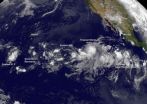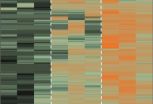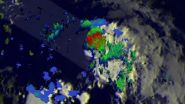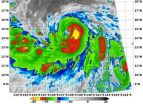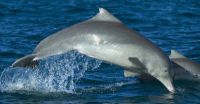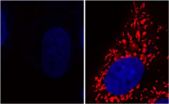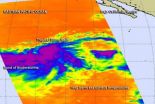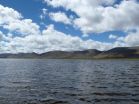(Press-News.org) A train of developing tropical low pressure areas stretch from the Eastern Pacific Ocean into the Central Pacific and they were captured in an image from NOAA's GOES-West satellite on August 1. The train of five tropical lows include the remnants of Tropical Storm Genevieve and newly developed Tropical Storm Iselle.
NOAA's GOES-West satellite captured an image of the Pacific Ocean on August 1 at 1200 UTC (8 a.m. EDT) that showed post-tropical cyclone Genevieve's remnants between three other systems. The GOES-West image shows the train of storms with a well-developed Iselle near the end of the train.
NOAA manages the GOES-West and GOES-East satellites. Data from the satellites are used to create images and animations from NASA/NOAA's GOES Project at NASA's Goddard Space Flight Center in Greenbelt, Maryland.
System 91C
The western-most tropical low pressure area lies to the west of Genevieve's remnants. That low is designated as System 91C. At 0600 UTC (2 a.m. EDT), the center of System 91C was located near 12.0 north latitude and 167.3 west longitude, about 850 miles southwest of Honolulu, Hawaii. 91C has a low chance of developing into a tropical depression over the next couple of days.
East of System 91C lie Genevieve's remnants. NOAA's Central Pacific Hurricane Center (CPHC) issued the final warning on Post-tropical cyclone Genevieve on July 31 at 1500 UTC (11 a.m. EDT). At that time it was centered near 13.0 north latitude and 151.1 west longitude, about 1,255 miles east of Johnston Island. It was moving west.
Genevieve's Remnants
At 8 a.m. EDT on August 1, Genevieve's remnant low center was located about 500 miles south-southeast of Hilo, Hawaii. CPHC noted the atmospheric conditions are only marginally favorable for its redevelopment over the next few days as it moves westward near 10 mph.
System 96E
Continuing east, System 96E is tracking behind Genevieve's remnants. System 96E is another developing low pressure area with a minimal chance for becoming a tropical depression. The CPHC gives System 96E a 10 percent chance of development over the next two days. It is located in the Eastern Pacific Ocean, about 1,275 miles east-southeast of the Big Island of Hawaii. Satellite imagery shows the low is producing minimal shower activity. CPHC noted that upper-level winds are currently not conducive for development, but they could become a little more favorable in a few days while the
low moves westward at around 10 mph.
Tropical Storm Iselle
Behind System 96E is the only developed tropical cyclone, Tropical Storm Iselle. Iselle is located east-northeast of System 96E. Tropical storm Iselle was born on July 31 at 2100 UTC (5 p.m. EDT). On August 1, Iselle's maximum sustained winds were already up to 60 mph (95 kph). At 5 a.m. EDT (2 a.m. PDT/0900 UTC).the center of Tropical Storm Iselle was located near latitude 13.5 north and longitude 124.6 west. Iselle is centered about 1,160 miles (1,870 km) west-southwest of the southern tip of Baja California, Mexico.
Fifth Area of Low Pressure
The fifth tropical low pressure area is east-southeast of Iselle. That area is a tropical wave that is producing disorganized showers and thunderstorms. That wave is located several hundred miles south-southwest of Manzanillo, Mexico. The National Hurricane Center noted that environmental conditions are conducive for gradual development of this system during the next several days while it moves westward at 10 mph. NHC gives this low a 30 percent chance of becoming a tropical depression over the next two days.
INFORMATION:
A train of 5 tropical cyclones in the Central and Eastern Pacific
2014-08-01
ELSE PRESS RELEASES FROM THIS DATE:
A map for eye disease
2014-08-01
Understanding eye diseases is tricky enough. Knowing what causes them at the molecular level is even more confounding.
Now, University of Iowa researchers have created the most detailed map to date of a region of the human eye long associated with blinding diseases, such as age-related macular degeneration. The high-resolution molecular map catalogs thousands of proteins in the choroid, which supplies blood and oxygen to the outer retina, itself critical in vision. By seeing differences in the abundance of proteins in different areas of the choroid, the researchers can ...
NASA finds heavy rainfall and wind shear in newborn Tropical Storm Bertha
2014-08-01
VIDEO:
This 3-D flyby of Tropical Storm Bertha on Aug. 1 was created from TRMM satellite data. It shows (from the south) intense thunderstorms were reaching heights of over 15km (about...
Click here for more information.
The Tropical Rainfall Measuring Mission satellite known as TRMM found rain was falling heavily in the Atlantic Ocean's second tropical storm of the hurricane season. Bertha was close to the Lesser Antilles, prompting warnings and watches.
The National Hurricane ...
Reptile Database surpasses 10,000 reptile species
2014-08-01
More than 10,000 reptile species have been recorded into the Reptile Database, a web-based catalogue of all living reptile species and classification, making the reptile species among the most diverse vertebrate groups in the world, alongside bird and fish species.
For some time, experts have projected that 2014 would mark the year that reptiles would become the most diverse vertebrate group in the world. Reptiles include snakes, lizards, turtles, crocodiles, tuataras and amphisbaenians.
"Officially, we have logged 10,038 reptile species into the database, which is ...
NASA sees Tropical Storm Halong's 'best side'
2014-08-01
NASA satellite data showed Tropical Storm Halong's "best side" or most powerful side was east of its center. That's where the coldest cloud top temperatures and strongest thunderstorms appeared on satellite imagery.
On August 1 at 13:30 UTC (9:30 a.m. EDT) the Moderate Resolution Imaging Spectroradiometer or MODIS instrument aboard NASA's Terra satellite captured an infrared picture of Tropical Storm Halong. The infrared data showed the coldest, strongest thunderstorm cloud-top temperatures east of the center of circulation. Cloud tops were as cold as -80F/-62C. Cloud ...
Advances in assisted reproduction create more options & new legal issues for LGBT couples
2014-08-01
New Rochelle, NY, August 1, 2014—Lesbian, gay, bisexual, and transgender individuals who want to conceive a child may face the same problems as some of their heterosexual and cisgendered peers, such as reduced fertility, but in addition they often face additional physiological and legal challenges to become parents. A comprehensive review of the most recent advances in assisted reproduction options is presented in the article "LGBT Assisted Reproduction: Current Practice and Future Possibilities," published in LGBT Health, a peer-reviewed journal from Mary Ann Liebert, ...
Scientists name new species of cetacean: The Australian humpback dolphin
2014-08-01
Scientists examining a taxonomically confused group of marine mammals have officially named a species new to science: the Australian humpback dolphin, Sousa sahulensis, according to the Wildlife Conservation Society and Clymene Enterprises.
The study describing the newly named species is the culmination of a 17-year long systematic examination of all available historical records, physical descriptions, and genetic data of humpback dolphins—a widespread group of coastal cetaceans ranging from the coast of West Africa to the northern coast of Australia. The Australian ...
Electronic reminders can help patients prevent surgical site infections
2014-08-01
CHICAGO (August 1, 2014)—The use of electronic reminders such as text messages, emails or voicemails is highly effective at getting surgical patients to adhere to a preadmission antiseptic showering regimen known to help reduce risk of surgical site infections (SSIs), according to a first-of-its-kind study published in the August issue of the Journal of the American College of Surgeons.
Each year approximately 400,000 SSIs occur and lead to a death rate approaching nearly 100,000 according to data sources cited by study authors. To help reduce the risk of these dangerous ...
Potential treatment and prevention of Parkinson's disease
2014-08-01
This news release is available in German.
Parkinson's disease affects neurons in the Substantia nigra brain region – their mitochondrial activity ceases and the cells die. Researchers at the Max Planck Institute of Molecular Cell Biology and Genetics show that supplying D-lactate or glycolate, two products of the gene DJ-1, can stop and even counteract this process: Adding the substances to cultured HeLa cells and to cells of the nematode C. elegans restored the activity of mitochondria and prevented the degeneration of neurons. They also showed that the two substances ...
NASA eyes powerful bands of thunderstorms in newborn Tropical Storm Iselle
2014-08-01
Tropical Storm Iselle was born in the Eastern Pacific Ocean soon after NASA's Aqua satellite gathered infrared imagery on the storm that showed powerful thunderstorms wrapping into developing storm's center. Iselle is not close enough to land to cause any watches or warnings.
The Atmospheric Infrared Sounder or AIRS instrument aboard NASA's Aqua satellite passed over System 95E on July 31 at 5:23 p.m. EDT from gathered infrared data before it became Tropical Storm Iselle. The data was made into a false-colored image at NASA's Jet Propulsion Laboratory in Pasadena, California. ...
Heavy metals and hydroelectricity
2014-08-01
Boulder, Colorado, USA – Hydraulic engineering is increasingly relied on for hydroelectricity generation. However, redirecting stream flow can yield unintended consequences. In the August 2014 issue of GSA Today, Donald Rodbell of Union College-Schenectady and coauthors from the U.S. and Peru document the wholesale contamination of the Lake Junín National Reserve by acid mine drainage from the Cerro de Pasco mining district.
According to the World Bank, about 60% of Peru's electricity is generated by hydropower, which during the dry season relies heavily on glacial meltwater ...
